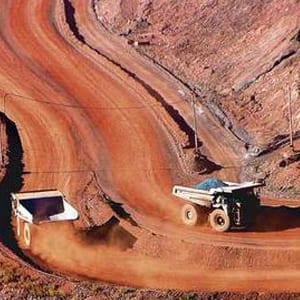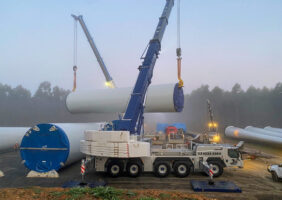An American solar power developer is targeting Australian miners as part of its international expansion plans, trying to convince operators that solar power plants can deliver baseload electricity, and cost less than diesel and probably gas as well.
The Santa Monica-based SolarReserve is currently constructing its 110MW Crescent Dunes solar tower with integrated energy storage near Tonopah in the Nevada desert. It will supply baseload power to Las Vegas between the hours of noon and midnight, on average..
But as we reported yesterday, and also in our solar tower explainer, SolarReserve’s technology can be configured in a variety of ways, and SolarReserve is looking at a scale down version of its technology – a plant of around 20-30MW – to meet the demands of Australian miners located in remote and off-grid locations.
The company is opening an office in Perth this coming summer, and is currently looking at five or six different proposals with mining groups. “The interest is there,” says Tom Georgis, the senior vice president for development at SolarReserve. “It is an education process, and they are certainly looking to the Nevada project and other projects we are developing.”
Mining and remote locations are looking like the most promising market opportunity for solar thermal technologies in the coming years, particularly given the excess capacity on the main grid in Australia, the reluctance of utilities to commit to power purchase agreements, and because wind energy will fill most of the space in the renewable energy target because of its current advantage in price.
SolarReserve previously had a project with an unnamed miner in Kalgoorlie that applied for funding under the Renewable Energy Development Program (the grant went to the Solar Oasis project using Australian technology, but that has now been pulled), and also looked at the Solar Flagships program.
It has also been holding talks with Alinta, which is considering replacing its coal-fired generators at Port Augusta with solar thermal, and other generators and utilities.
Georgis says solar with storage makes sense because it can deliver reliable electricity, at less cost than current alternatives. He says the cost of electricity from a plant would be around $160-$165/MWh in solar-rich Western Australia. That puts it well below diesel, which costs $250/MWh and in some cases much more.
“Our technology is more attractive than diesel. But the mining sector is conservative, so the question is if the gap is going to be big enough in price to encourage them to move off diesel and to adopt this technology.”
He says this is where the Australian Renewable Energy Agency and Clean Energy Finance Corporation could play a role. ARENA has set specific funds aside to promote such investments, and the CEFC is keen to offer cheaper loans to bridge the gap between what the customer wants and what the developer can deliver.
“It’s the fringe, off-grid, peaking opportunities that make sense,” Georgis says. “Australia has a great resource, funding support mechanisms as they exist today, rule of law, sanctity of contract, credit worthiness – all the things we look for in a market.”
Georgis says there is a lot of skepticism about the technology, and confusion about costs, but this should be addressed by the opening of the Crescent Dunes facility mid next year.
“There are always white papers and experts giving their opinion about costs, and there is a bias and great skepticism (against solar). I was in natural gas before solar, and I saw $3/mmbtu and I saw $15/mmbtu. We’ll see that again when the U.S. starts exporting (gas).
“When mining entities are looking at expansion plans, they’re asking themselves if they will build a gas combined cycle plant on the coast, and transmit the electricity inland, whether they stick with diesel, or do a mixture of diesel and PV. Our job is to say this is what you need to consider, and by the time they make that decision, Crescent Dunes will be up and operating.
“We think that the story makes sense regardless of who is in power, because the mining sector needs alternative technologies for economic reasons, and it’s impractical to run 500km gas pipelines, or run expensive transmission lines. That is our primary target. Connecting into NEM is not possible in near term due to economic pricing point.”
Georgis says SolarReserve is currently developing an “M-class” model of the technology that would be suitable for such projects. By scaling down the generator, the plant can deliver power 24/7. It could be used as a hybrid with solar PV, storing energy for later use as the panels provide electricity during the day.
And – because power purchase agreements with miners are generally shorter – 10-15 years – than the grid-tied PPAs because of the life of the mine, the plant could be demountable, so it could be moved to another project.
It would also have some sort of small fossil fuel back-up to satisfy the miners’ craving for capacity factors of near 100 per cent.
“But we don’t need a bunch of diesel gen-sets. We can run a loop with some fossil fuels. We do exhaustive analysis of a specific location and what our fuel resource is, which is the sun, so we know that in a specific location it may rain for two weeks, or there could be some other weather event, or maintenance, any of which might require a back up generator. We can use some diesel to reach high capacity factors in situations like these.”
“The advantage to the miner is that there is no fossil fuel infrastructure. You don’t need a gas pipeline, or huge diesel gen-set array, or CCGT. There is no pricing volatility, given the sun is free. We will take the risk on diesel. And there are no emissions apart from bit of diesel we use, if necessary.”
“We are hopeful that the CEFC will remain in place and remain funded. It’s a great program, it makes perfect sense. On the mining sector, it’s a win-win. It’s an economic benefit to miners so that they can displace natural gas or expensive diesel. It’s a pure economic argument.”








